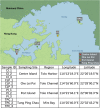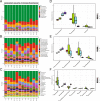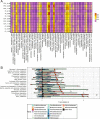A pollution gradient contributes to the taxonomic, functional, and resistome diversity of microbial communities in marine sediments
- PMID: 31307536
- PMCID: PMC6632204
- DOI: 10.1186/s40168-019-0714-6
A pollution gradient contributes to the taxonomic, functional, and resistome diversity of microbial communities in marine sediments
Abstract
Background: Coastal marine environments are one of the most productive ecosystems on Earth. However, anthropogenic impacts exert significant pressure on coastal marine biodiversity, contributing to functional shifts in microbial communities and human health risk factors. However, relatively little is known about the impact of eutrophication-human-derived nutrient pollution-on the marine microbial biosphere.
Results: Here, we tested the hypothesis that benthic microbial diversity and function varies along a pollution gradient, with a focus on human pathogens and antibiotic resistance genes. Comprehensive metagenomic analysis including taxonomic investigation, functional detection, and ARG annotation revealed that zinc, lead, total volatile solids, and ammonia nitrogen were correlated with microbial diversity and function. We propose several microbes, including Planctomycetes and sulfate-reducing microbes as candidates to reflect pollution concentration. Annotation of antibiotic resistance genes showed that the highest abundance of efflux pumps was found at the most polluted site, corroborating the relationship between pollution and human health risk factors. This result suggests that sediments at polluted sites harbor microbes with a higher capacity to reduce intracellular levels of antibiotics, heavy metals, or other environmental contaminants.
Conclusions: Our findings suggest a correlation between pollution and the marine sediment microbiome and provide insight into the role of high-turnover microbial communities as well as potential pathogenic organisms as real-time indicators of water quality, with implications for human health and demonstrate the inner functional shifts contributed by the microcommunities.
Keywords: Antibiotic resistance genes; Marine sediments; Metagenomics; Pollution concentration.
Conflict of interest statement
The authors declare that they have no competing interests.
Figures





References
-
- McKee JK, Sciulli PW, Fooce CD, Waite TA. Forecasting global biodiversity threats associated with human population growth. Biol Conserv. 2004;115:161–164. doi: 10.1016/S0006-3207(03)00099-5. - DOI
-
- Phillips DJ. The use of biological indicator organisms to monitor trace metal pollution in marine and estuarine environments—a review. Environ Pollution (1970) 1977;13:281–317. doi: 10.1016/0013-9327(77)90047-7. - DOI
Publication types
MeSH terms
Substances
LinkOut - more resources
Full Text Sources
Medical

